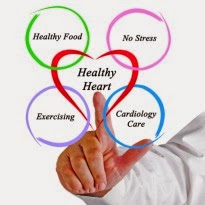Heart
Day is part of an international campaign to spread awareness about heart
disease and stroke prevention. This is the perfect day to quit smoking, get
exercising and start eating healthy – all in the name of keeping your ticker in
good working order, and improving the health and well being of people the world
over.
The
World Heart Federation have found that heart disease and strokes are the
world’s leading cause of death, killing 17.1 million people every year – that’s
more than victims of cancer, HIV and AIDS and malaria.
Overeating,
lack of exercise, unhealthy diets and high blood pressure, cholesterol and
glucose levels are all factors which can trigger heart disease and threaten our
own lives, and those of loved ones. Heart Day was set up to drive home the
message that heart problems can be prevented.
Cardiovascular
diseases are the number one cause of death worldwide and this is projected to
remain so, according to WHO. About 17.5 million people died from cardiovascular
disease in 2005, representing 30 percent of all global deaths. Risk factors
that may lead to heart disease and stroke include:
- Raised blood pressure, cholesterol and glucose levels
- Smoking
- Inadequate intake of fruit and vegetables
- Overweight
- Obesity
- Physical inactivity
The
aim is to improve health globally by encouraging people to make lifestyle
changes and promoting education internationally about ways to be good to your
heart.
A
heart-healthy diet can reduce your risk of heart disease or stroke by 80%. By
understanding which foods and methods of cooking are healthiest for your heart,
you may be able to prevent or manage heart disease and high blood pressure, and
take greater control over the quality and length of your life.
Of
all the possible improvements you can make to your diet, limiting saturated
fats and cutting out trans fats entirely is perhaps the most important.
Both
types of fat raise your LDL, or “bad” cholesterol level, which can increase
your risk for heart attack and stroke
Eat
More
|
Eat
Less
|
Healthy fats: raw nuts, olive oil, fish oils, flax seeds, or
avocados
|
Trans fats from partially hydrogenated or deep-fried
foods; saturated fats from whole-fat dairy or red meat
|
Nutrients: colorful fruits and vegetables—fresh or frozen,
prepared without butter
|
Packaged foods of any kind, especially those high in
sodium
|
Fiber: cereals,
breads, and pasta made from whole grains or legumes
|
White or egg breads, granola-type cereals, refined pastas
or rice
|
Omega 3 and protein: fish and shellfish, poultry
|
Red meat, bacon, sausage, fried chicken
|
Calcium and protein: Egg whites, egg substitutes, skim or 1% milk,
low-fat or nonfat cheeses or yogurt
|
Egg yolks, whole or 2 percent milk, whole milk products
like cheese or yogurt
|
Here
are some ideas about how to get started:
- Choose whole-grain bread instead of white bread.
- Have a piece of fruit instead of a candy bar.
- Try to eat at least 5 servings of fruits and vegetables every day. Add one or two servings of fruits and vegetables to your day. Slowly add more servings until you are eating at least 5 servings a day.
- Switch from 2% or whole milk to 1% or nonfat milk.
- Instead of meat, have fish for dinner. Brush it with olive oil, and broil or grill it.
- Switch from butter to a cholesterol-lowering soft spread. Use olive or canola oil for cooking.
- Use herbs and spices, instead of salt, to add flavor to foods.
- Modify your favorite recipes so they have less fat and calories but still taste good.
- It may take some time to get used to new tastes and habits, but don't give up. Keep in mind the good things you are doing for your heart and your overall health.


No comments:
Post a Comment